Kitchen pantry shelving is essential for an organized kitchen. No matter the size, the right shelves improve storage.
Imagine quickly finding ingredients, keeping your kitchen neat, and making meal prep easier.
With options like adjustable shelves and pull-out drawers, you can make the most of your pantry space.
Here are 10 clever pantry shelving ideas you’ll wish you knew earlier.
5 Reasons Kitchen Pantry Shelving Will Transform Your Kitchen
- Maximized Storage Space: Efficient shelving systems help utilize every inch of your pantry, increasing storage capacity.
- Improved Organization: Adjustable shelves and compartments allow for organized storage of pantry items, making everything easily accessible.
- Enhanced Visibility: Proper shelving ensures that all items are visible, reducing the chances of forgotten or expired goods.
- Customizable Layout: Modular shelving options allow you to tailor the pantry to your specific needs and preferences.
- Aesthetic Appeal: Stylish shelving solutions can enhance the overall look of your kitchen, adding to its visual appeal.
10 Must-Try Kitchen Pantry Shelving Ideas That Maximize Storage
1. Dedicate Each Shelf to a Specific Purpose
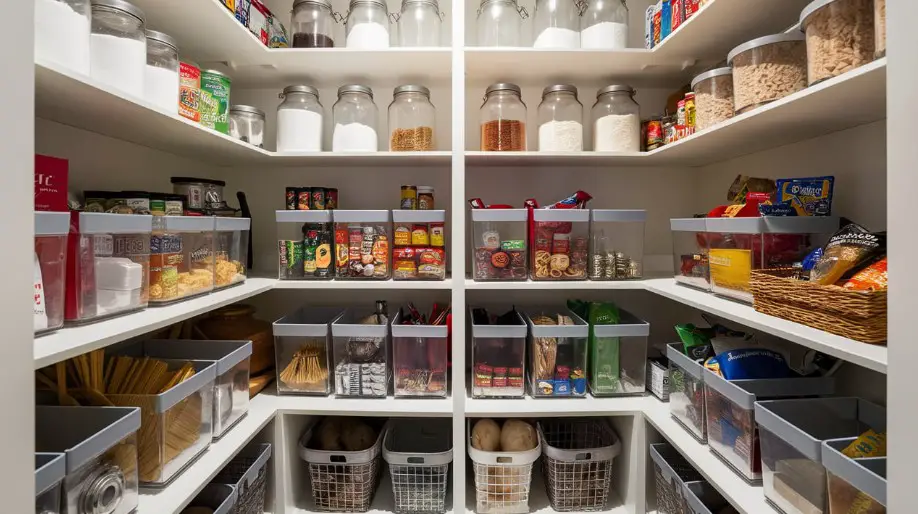
One good way to organize your pantry is by assigning each shelf a category. This makes cooking easier because you can find everything quickly.
For example, use the top shelf for baking items like flour and sugar. Set aside the middle shelves for canned goods and snacks. Use the bottom shelf for heavier items, such as large bags of rice or potatoes.
You can use clear bins or baskets to group similar items. This keeps things neat and lets you see what you have easily.
Labeling each bin helps with organization. This way, everyone knows where to find and return items.
This smart setup reduces clutter and boosts efficiency in your cooking space. It makes meal prep straightforward.
- Sort your pantry by dedicating each shelf to a category—baking essentials, canned goods, or bulk items—for effortless meal prep. Need storage solutions? Check out Amazon for pantry organizers!
2. Utilize Vertical Space
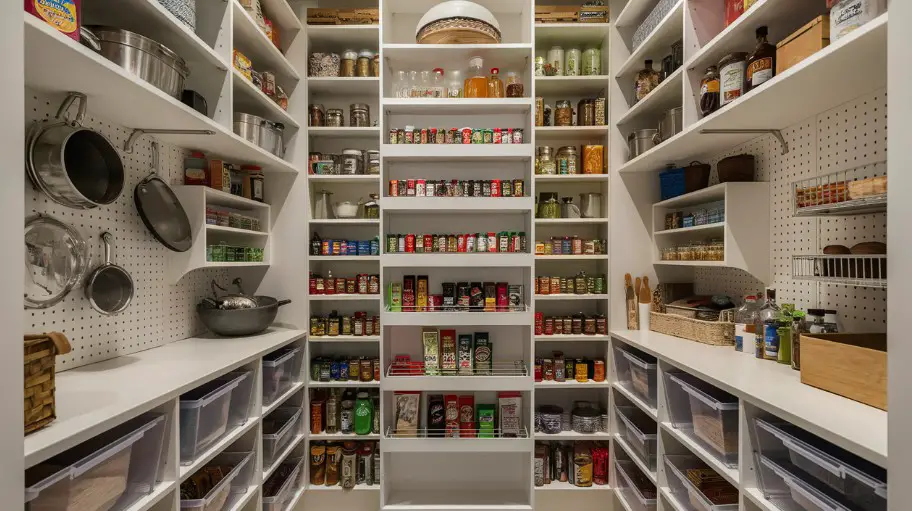
Maximizing vertical space is key in any pantry, especially with limited room.
Install extra shelves that reach the ceiling. This lets you store less-used items up high while keeping daily essentials easy to grab.
Use tiered shelving units for smaller items like spices and packets. This makes them visible and accessible.
Wall-mounted shelves or pegboards work well for hanging pots, pans, and small spice jars. This frees up valuable shelf space.
In a narrow pantry, try slim, stackable bins to fit tight spaces.
By fully using vertical space, you create a more open and organized pantry. This ensures every item has its own spot.
- Maximizing vertical space is key to an organized pantry. Install ceiling-high shelves or tiered racks to keep essentials accessible. Need storage solutions? Check Amazon for space-saving pantry organizers.
3. Use Clear Storage Containers
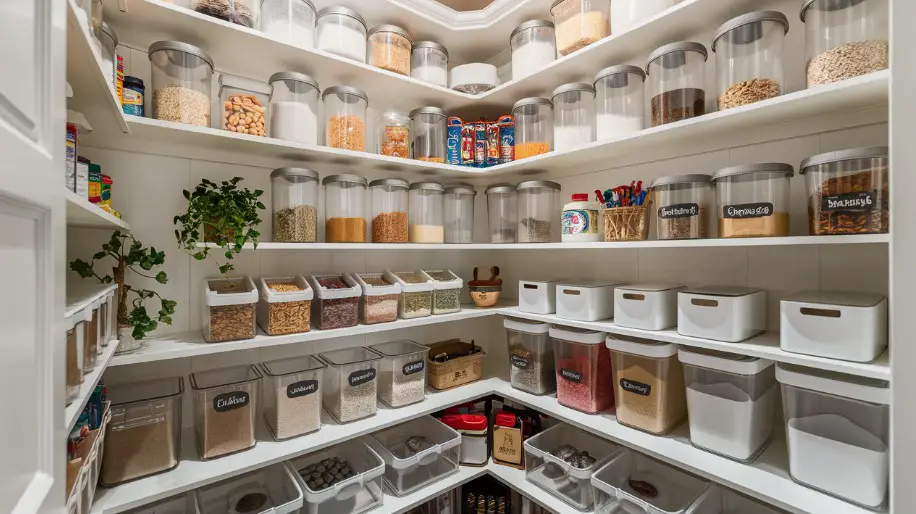
Investing in clear storage containers can change your pantry for the better.
You can easily see what’s inside. This helps you keep track of items and avoid buying duplicates.
Choose airtight containers to keep dry goods fresh. They also stop pests from getting into your pantry. You can sort items by type—like grains, snacks, and baking supplies—and label each container for quick access.
This makes your pantry look nice and simplifies meal prep. It’s easy to grab what you need.
For a unified look, pick containers that are similar in style and size. This creates a clean appearance.
With clear containers, your pantry can be both tidy and attractive.
- Organizing your pantry with clear storage containers boosts both style and efficiency. Want to upgrade your kitchen storage? Check out top-rated airtight containers on Amazon.
4. Incorporate Lazy Susans
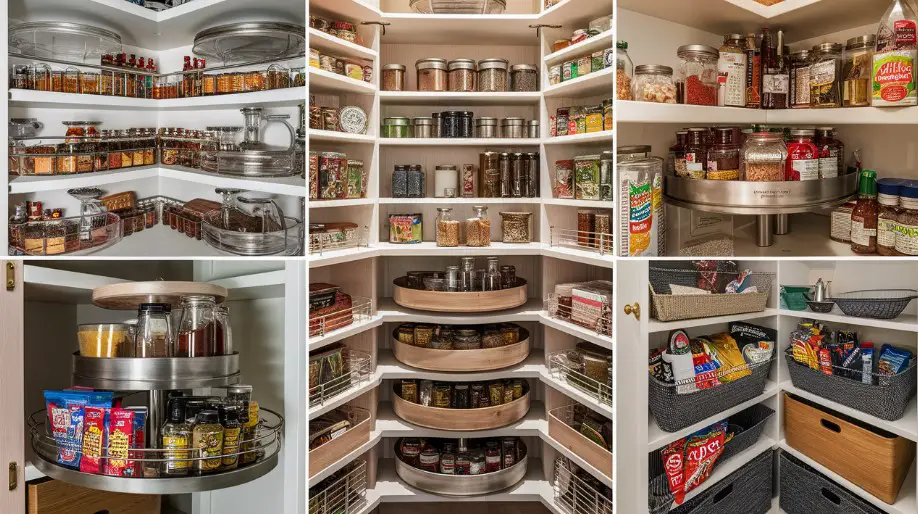
Lazy Susans are great for any pantry, especially in corner shelves where items get lost.
These rotating trays let you reach items easily. You won’t have to dig through stacks of containers. Use them for spices, condiments, or snacks. This way, you can find what you need quickly.
Lazy Susans come in different sizes and materials. Pick ones that match your pantry’s style.
You can also combine them with baskets or bins for a versatile storage space.
With Lazy Susans, you can boost storage efficiency and keep your pantry neat and easy to use.
- Tired of losing items in deep pantry corners? A Lazy Susan keeps everything within reach! Find the perfect one to match your space—shop now for stylish and functional options.
5. Create Zones for Different Categories
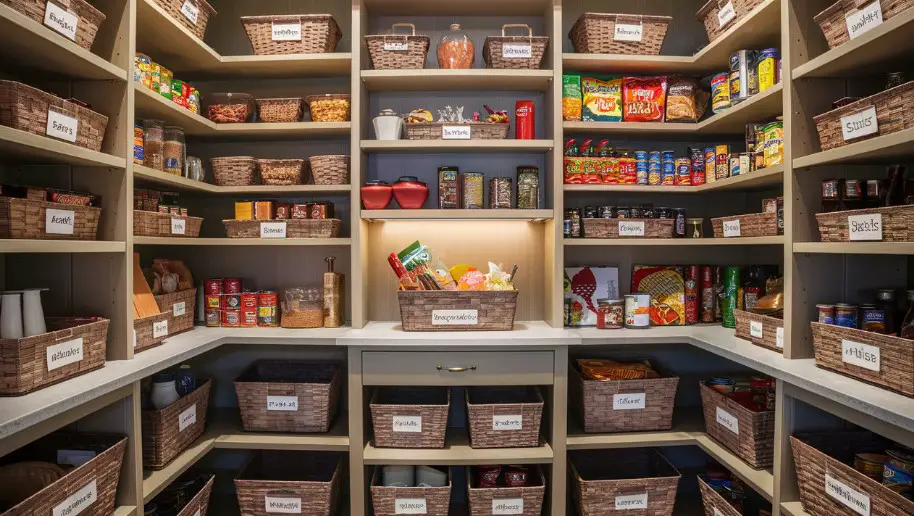
Dividing your pantry into zones boosts organization and efficiency. Create areas for baking supplies, snacks, canned goods, and spices.
This method helps you find items quickly. It also encourages grouping similar products. Use baskets or bins to mark each zone and label them for easy identification.
For example, have a basket for breakfast items, another for baking essentials, and a shelf for canned goods.
This zoning technique is great for busy households. It helps everyone know where to find and return items.
By setting clear zones, you can keep a tidy and efficient pantry that meets your family’s needs.
- Organizing your pantry into dedicated zones for snacks, baking essentials, and canned goods makes finding items effortless. Need storage solutions to streamline the process? Check out Amazon for stylish pantry organizers.
6. Install Pull-Out Shelves
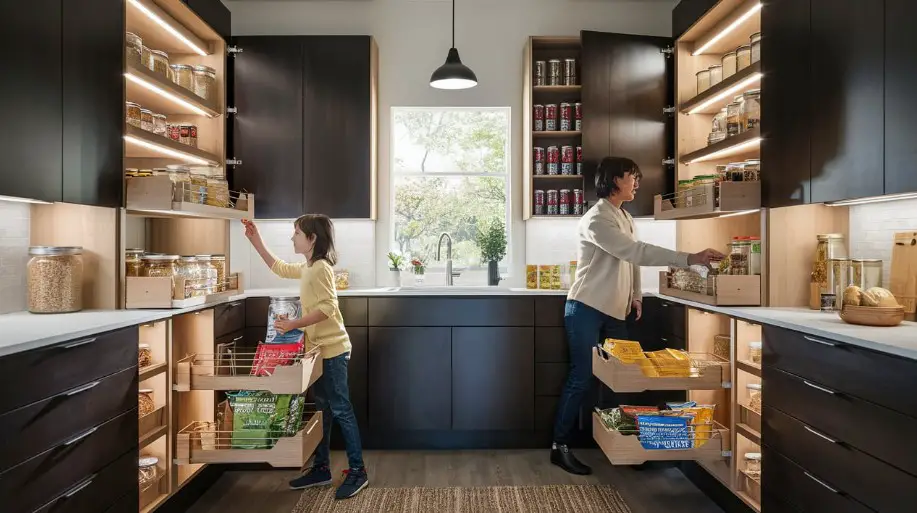
Pull-out shelves make the most of pantry space, especially in deep cabinets where items can get lost.
These shelves slide out smoothly. You can reach everything without digging into the back. Install them in both upper and lower cabinets to make organization easier.
Think about using pull-out baskets for snacks or produce. They keep items visible and accessible.
This feature is excellent for families. It allows kids to grab snacks easily and helps everyone find what they need without trouble.
Add pull-out shelves to transform your pantry into a user-friendly area. This upgrade enhances your cooking experience.
- Maximize your pantry space with pull-out shelves—no more digging through deep cabinets! Want an easy upgrade? Check out top-rated pull-out organizers on Amazon.
7. Use Door Space Wisely
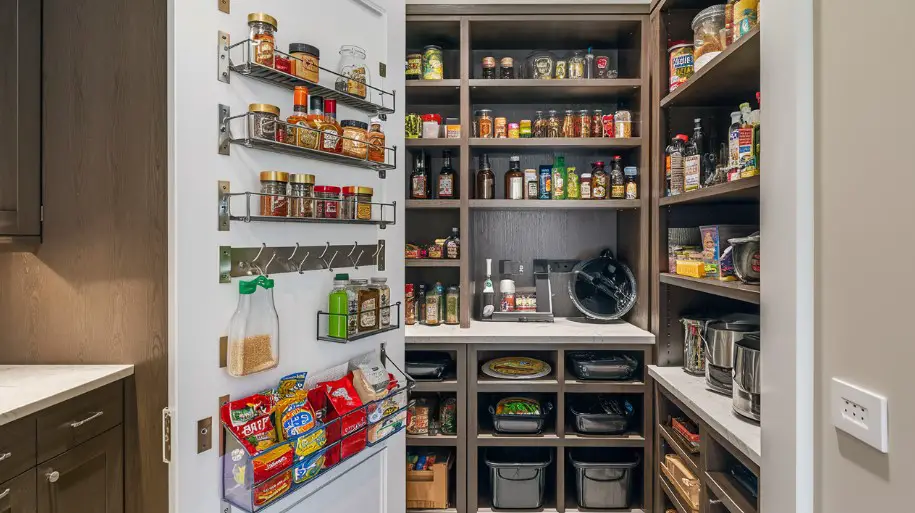
The inside of your pantry door is often ignored, but it can add valuable storage space.
You can install racks or hooks to make room for spices, small jars, or cleaning supplies.
An over-the-door shoe organizer is great for snacks or other small items. This helps keep your pantry tidy.
This method maximizes storage and keeps frequently used items close at hand. Plus, using the door frees up shelf space for larger items.
By using door space well, you can create a more organized pantry that makes the most of every inch.
- Don’t let your pantry door space go to waste! Add racks, hooks, or organizers to store spices, snacks, and more. Need smart storage solutions? Check Amazon for top-rated pantry organizers.
8. Add a Library Ladder for High Shelves
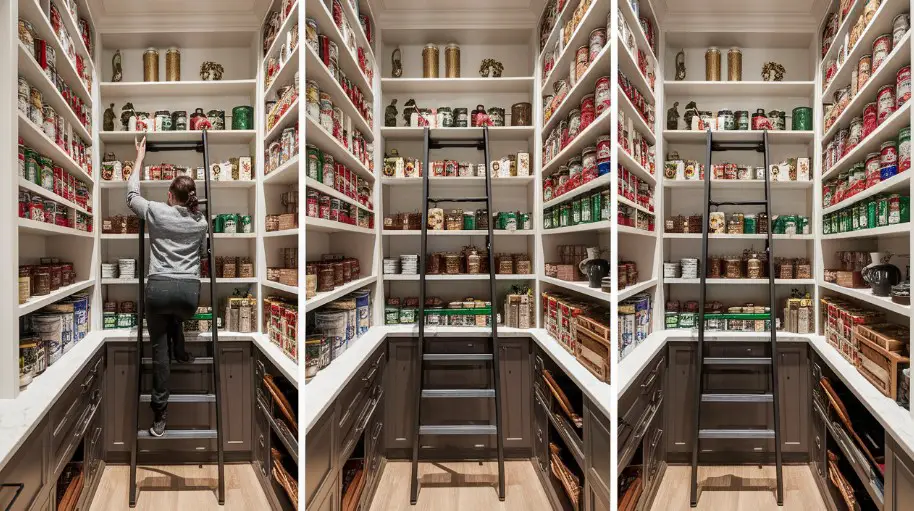
If your pantry has high shelves, a library ladder is a stylish and practical choice. It lets you reach items on top safely, avoiding unstable stools or chairs.
Pick a ladder that fits your kitchen’s style. You could choose a sleek modern look or a rustic wooden one.
A library ladder adds elegance to your pantry and makes every shelf easy to reach. This is great for bulk items or seasonal goods that you don’t need often.
With a library ladder, your pantry can be both beautiful and functional.
- A library ladder adds both elegance and function to your pantry, making high shelves easily accessible. Want one that fits your style? Explore stylish options on Amazon.
9. Label Everything
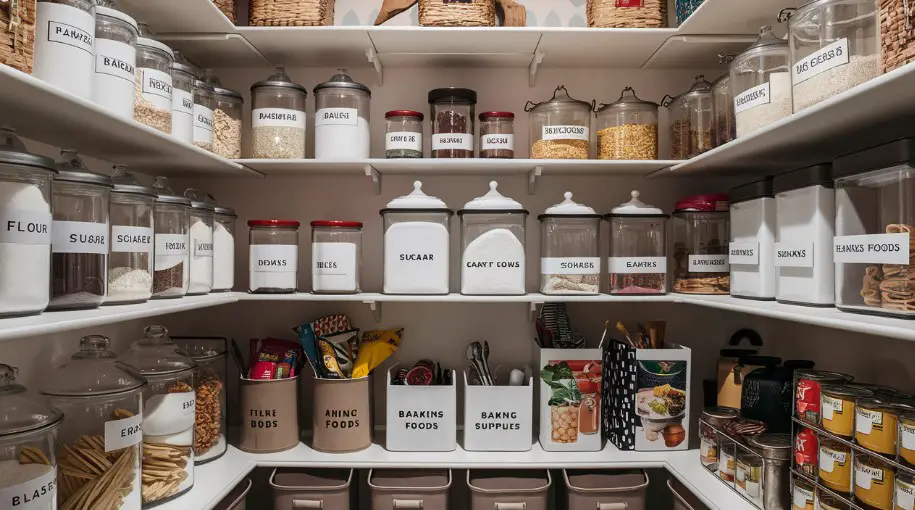
Labeling is essential for an organized pantry. Clear labels on containers, shelves, and bins help everyone know where things go. This makes it easier to keep the space tidy.
Use a consistent labeling system—handwritten, printed, or decorative labels—for a unified look.
Label containers and shelves. This shows where each item belongs.
This approach benefits busy households. It helps everyone return items to their spots.
Taking time to label creates a more organized and functional pantry. It will be easy to find what you need.
- A well-labeled pantry keeps everything in its place, making organization effortless. Want stylish labels to match your aesthetic? Check out Amazon for chic pantry labeling solutions!
10. Repurpose Unused Items
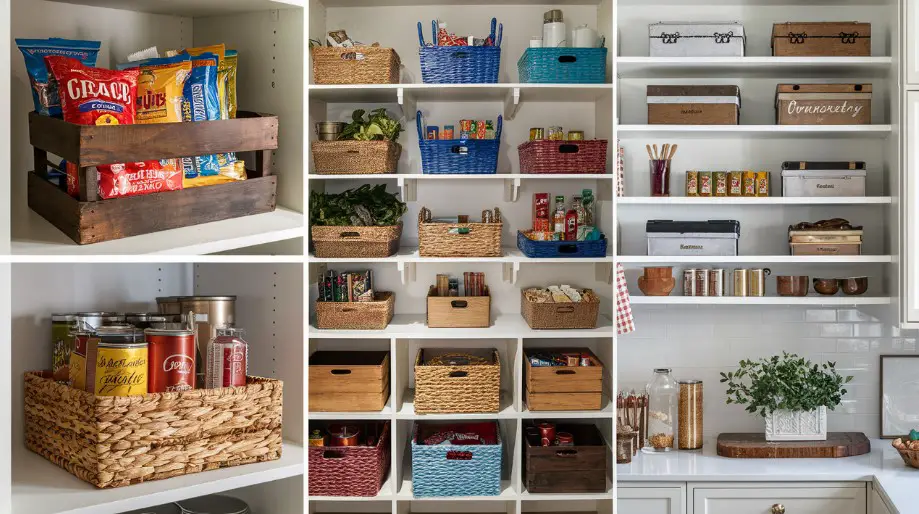
Lastly, get creative with unused items for pantry storage. Old crates, baskets, and decorative boxes can be stylish storage solutions.
For example, use a vintage crate for snacks or a decorative box for tea bags and spices.
This method adds character to your pantry and personalizes the space.
Plus, using repurposed items saves money while improving organization without buying new storage.
By thinking outside the box, you can craft a unique, functional pantry that reflects your style while keeping everything tidy.
Additional tips for organizing your kitchen pantry:
- Store like items together. Group together items that are used for the same purpose, such as baking supplies or cooking utensils. This will make it easier to find what you need when you’re cooking.
- Keep frequently used items at eye level. This will make it easier to grab what you need without having to dig through your pantry.
- Rotate your stock. Make sure to rotate your stock so that the oldest items are used first. This will help you to avoid food waste.
- Clean your pantry regularly. A clean pantry is a more organized pantry. Take some time each week to clean out your pantry and remove any expired or outdated items.
By following these tips, you can create a kitchen pantry that is both organized and efficient. This will make your life easier and help you to save time and money.
Here are some specific examples of kitchen pantry shelving ideas:
- For a small pantry, you can use vertical shelving to create more storage space. You can also use stackable shelves to save space.
- For a large pantry, you can use adjustable shelves to create different storage zones. You can also use deep shelves for bulky items and shallow shelves for small items.
- If you have a lot of spices, you can use a spice rack or a lazy Susan to keep them organized. You can also use baskets or bins to store small kitchen gadgets.
- If you have a lot of canned goods, you can use a can organizer to keep them organized. You can also use a rolling cart to store canned goods and other pantry items.
No matter what the size of your kitchen pantry, there are plenty of shelving ideas to help you organize it and keep it looking its best. By following these tips, you can create a pantry that is both functional and stylish.
What materials are best for kitchen pantry shelves?
When selecting materials for kitchen pantry shelves, it’s crucial to consider durability, ease of maintenance, and aesthetic appeal. Solid wood, such as maple or oak, is a top choice for its strength and classic look.
These hardwoods can support heavy pantry items and add a warm, timeless touch to the kitchen. Plywood is another excellent option, offering a balance of strength and affordability. It resists warping and is versatile for various shelf designs.
For a more modern and sleek appearance, metal shelves, particularly stainless steel, are highly recommended. Stainless steel is not only sturdy but also easy to clean and resistant to moisture and pests.
Wire shelving, often coated with epoxy, is another practical choice. It provides excellent ventilation, preventing mold and allowing visibility of stored items.
Lastly, melamine-coated shelves, made from particleboard or MDF, offer a budget-friendly solution.
They are easy to clean and come in various finishes to match kitchen decor. Choosing the right material depends on balancing budget, style, and the specific needs of the kitchen pantry.
How do I install adjustable shelves in my kitchen pantry?
Installing adjustable shelves in a kitchen pantry can transform the space into an organized and efficient storage area. Here’s a step-by-step guide to help you get it done:
- Measure the Space: Begin by measuring the height, width, and depth of the pantry. Determine how many shelves you need and how much vertical space each shelf requires based on the items you plan to store.
- Select Shelving Material: Choose sturdy, adjustable shelving units or brackets that can support the weight of pantry items. Common materials include wood, metal, or wire.
- Mark the Wall: Use a level to draw horizontal lines where the shelves will be placed. Ensure these lines are even and level for stability.
- Install Shelf Standards: Attach the vertical shelf standards to the wall studs using screws. These standards should be spaced appropriately to support the length of the shelves.
- Position the Brackets: Insert adjustable brackets into the shelf standards at the desired heights. Make sure they are securely in place to prevent wobbling.
- Place the Shelves: Lay the shelves onto the brackets, ensuring they are level and stable. Adjust the height of the brackets if needed to accommodate different items.
- Secure the Shelves: If necessary, use screws to secure the shelves to the brackets for added stability.
By following these steps, installing adjustable shelves in a kitchen pantry becomes a straightforward task, resulting in a neatly organized and easily accessible space.
How can I organize my kitchen pantry shelves efficiently?
Organizing kitchen pantry shelves efficiently can transform cooking and meal prep into a seamless experience.
Begin by emptying the pantry and grouping similar items together. Categorize food items such as grains, snacks, canned goods, and spices, which makes finding and storing items easier.
Utilize clear, labeled containers for dry goods like pasta, rice, and cereals to maintain freshness and visibility. Consider using stackable bins or baskets for grouping similar items, making the most of vertical space.
Install adjustable shelving to accommodate items of varying heights and keep frequently used items at eye level for easy access. Lazy Susans or turntables can be perfect for hard-to-reach corners, making every item reachable.
Implement a first-in, first-out system by placing newer items behind older ones, ensuring food gets used before it expires. Door-mounted racks can provide additional storage for smaller items or spices.
Regularly review the pantry, discarding expired items and reorganizing as necessary. Keeping the pantry tidy not only enhances efficiency but also helps in maintaining a clutter-free kitchen, making meal preparation a more enjoyable task.
